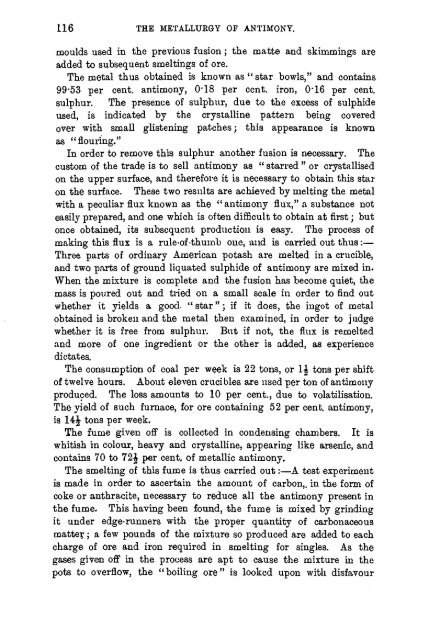antimony - Sciencemadness.org
antimony - Sciencemadness.org
antimony - Sciencemadness.org
Create successful ePaper yourself
Turn your PDF publications into a flip-book with our unique Google optimized e-Paper software.
116 THE METALLURGY OF ANTIMONY.<br />
moulds used in the previous fusion; the matte and skimmings are<br />
added to subsequent smeltings of ore.<br />
The metal thus obtained is known as " star bowls," and contains<br />
99*53 per cent, <strong>antimony</strong>, 0*18 per cent, iron, 0*16 per cent,<br />
sulphur. The presence of sulphur, due to the excess of sulphide<br />
used, is indicated by the crystalline pattern being covered<br />
over with small glistening patches; this appearance is known<br />
as "flouring."<br />
In order to remove this sulphur another fusion is necessary. The<br />
custom of the trade is to sell <strong>antimony</strong> as " starred " or crystallised<br />
on the upper surface, and therefore it is necessary to obtain this star<br />
on the surface. These two results are achieved by melting the metal<br />
with a peculiar flux known as the " <strong>antimony</strong> flux," a substance not<br />
easily prepared, and one which is often difficult to obtain at first; but<br />
once obtained, its subsequent production is easy. The process of<br />
making this flux is a rule-of-thumb one, and is carried out thus:—<br />
Three parts of ordinary American potash are melted in a crucible,<br />
and two parts of ground liquated sulphide of <strong>antimony</strong> are mixed in.<br />
When the mixture is complete and the fusion has become quiet, the<br />
mass is poured out and tried on a small scale in order to find out<br />
whether it yields a good, "star"; if it does, the ingot of metal<br />
obtained is broken and the metal then examined, in order to judge<br />
whether it is free from sulphur. But if not, the flux is remelted<br />
and more of one ingredient or the other is added, as experience<br />
dictates.<br />
The consumption of coal per week is 22 tons, or 1 £ tons per shift<br />
of twelve hours. About eleven crucibles are used per ton of <strong>antimony</strong><br />
produced. The loss amounts to 10 per cent., due to volatilisation.<br />
The yield of such furnace, for ore containing 52 per cent, <strong>antimony</strong>,<br />
is 14 J tons per week.<br />
The fume given off is collected in condensing chambers. It is<br />
whitish in colour, heavy and crystalline, appearing like arsenic, and<br />
contains 70 to 72£ per cent, of metallic <strong>antimony</strong>.<br />
The smelting of this fume is thus carried out:—A test experiment<br />
is made in order to ascertain the amount of carbon,, in the form of<br />
coke or anthracite, necessary to reduce all the <strong>antimony</strong> present in<br />
the fume. This having been found, the fume is mixed by grinding<br />
it under edge-runners with the proper quantity of carbonaceous<br />
matter.; a few pounds of the mixture so produced are added to each<br />
charge of ore and iron required in smelting for singles. As the<br />
gases given off in the process are apt to cause the mixture in the<br />
pots to overflow, the "boiling ore" is looked upon with disfavour
















